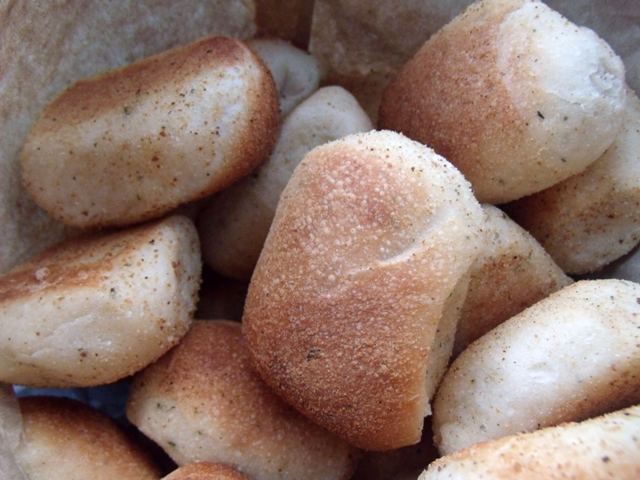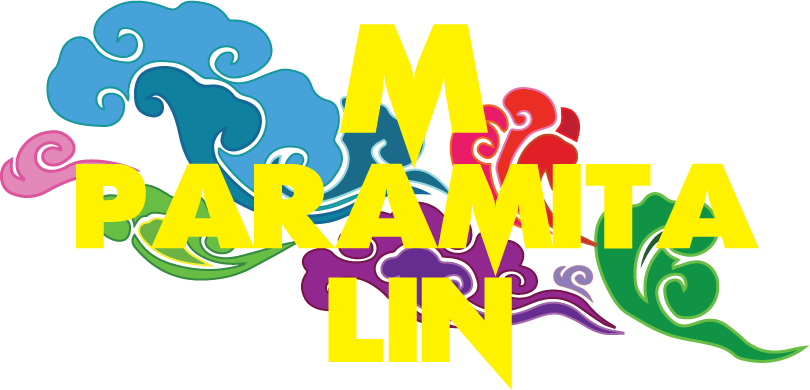
Image by RNJ Malunggay Pandesal [CC BY-SA 4.0], from Wikimedia Commons
Postcolonial life is strange. Every day, you are reminded that you are in a country that was once crushed under the boot of a European colonizer: the advertisements featuring white-looking models, the preference given to colonial architecture, the belief that anything or anyone foreign is better than local. But at the same time, the impact of colonization on local culture is so profound that no one even realizes it’s there. It’s simply taken for granted that this is how things are meant to be.
Colonization leaves its mark on everything, but often, the most immediate way people interact with colonization in daily life is through food. Colonizers bring in new ingredients and new techniques, which are eventually incorporated by the local inhabitants into their own cooking. After a few years, these dishes become part of the cultural identity. (This isn’t the only way that local food evolves, of course. Trade and exposure to other cultures inevitably change how food is prepared or even what is considered “food” in the first place.)
The provenance of dishes sometimes becomes divorced from how locals feel about the cultures that inspired them. Think, for example, of the huge influence of Chinese cooking in Asia which doesn’t prevent the many cultures that have incorporated Chinese food into their own cuisines from harbouring anti-Chinese sentiments to this day. In contrast, the food that is descended from the colonizing culture–regardless of their barbarity towards the local inhabitants–continues to benefit from a widely accepted notion that it’s fancier than local food because of its origins. It doesn’t hurt that the ingredients are often expensive and hard to find locally, thus emphasizing the cuisine’s superiority.
And then you get food like pandesal, a product of colonization that was spread widely thanks to the belief that foreign is better, but trickled down through time into the bellies of the poor.
Pandesal is a bread roll coated in breadcrumbs named from the Spanish “pan de sal”, meaning “bread of salt”. It’s usually eaten for breakfast or as a snack during merienda, dressed up in various ways according to class. If you have money, then it’s spread with New Zealand butter and perhaps jam or sardines or condensed milk. Those less fortunate might make do with local margarine or forgo condiments entirely and simply dip their pandesal in sweetened barako coffee.
It’s the only staple bread in the Philippines, so widely eaten that its price, 3 pesos (or six cents USD) per roll, has been fixed since at least the 1960s, making it an unofficial indicator of buying power. As told by Philippine National Scientist sociologist Gelia Castillo to Robert H. Boyer in his book Sundays in Manila, the size of pandesal changes according to how the economy is doing. In effect, if the economy is doing well, you get pandesals that are the size of a woman’s fist, but if things are bad, they shrink down to the size of chicken eggs, but at least people can take comfort that the price remains the same.
Pandesal’s evolution from a food item meant only for the Spanish colonizers to a humble bread eaten by everyone is an example of how the complexities of colonization work their way through society, of the histories that are hidden or suppressed in the process, and the effects that persist to this day.
The Spanish colonizers established the first royal bakery in the Philippines in 1625 inside Intramuros, the Walled City where only Spanish people were allowed (aside from their servants and workers), and bread was only meant for their consumption. Food historian Felice Sta. Maria explains that the colonizers were unaccustomed to eating rice and depended on bread–rather a problem since wheat was not grown in the Philippines. In fact, to this day, even though pandesal and other breads are eaten every day, wheat is still not grown locally, despite regions temperate enough to support its farming.
Perhaps it should be noted that the Philippines used to be a US colony (yes, one colonizer after another, Jesus), and 90 per cent of its wheat imports come from the US, making it the third biggest market for US wheat. But maybe that’s all just a coincidence because certainly, foreign businesses and their government representatives have never bribed or cajoled local corrupt politicians to ensure that their interests are protected in the Philippines.
Other than the lack of flour, the other issue that the Royal Bakery faced was that the bakers among the Spanish preferred to speculate in the galleon trade rather than spend their days labouring at a bakery, and the native Filipinos didn’t have the training or experience to work there. To fill the gap, Chinese labourers with baking experience were hired to bake the bread under Spanish supervision and the flour needed for baking, first imported from Mexico, was later brought in from China.
And it wasn’t just flour that the Chinese brought in; they had been trading in the Philippines and had established communities and enterprises there long before the Spanish arrived. During the early period of colonization, the Spanish were only interested in the galleon trade, and so they ended up relying on imported Chinese goods or local Chinese artisans for their necessities. It also goes without saying that access to China was an important reason for colonizing the Philippines (as it is today), but the Spanish managed to hang on to their loathing of Chinese people despite the galleon trade. The Chinese were “economically necessary but culturally undesirable and politically untrustworthy.”
While the Filipino inhabitants took to Catholicism and the Spanish culture, most Chinese remained frustratingly uninterested in Jesus and barbaric European customs. The colonizers’ dislike of the Chinese trickled down to the Filipinos, who would assist the Spanish in the periodic massacres of the Chinese population. John Foreman, a Fellow of the Royal Geographic Society, wrote about the massacres with some sympathy towards the Chinese in a 1899 book of his observations of the Philippines, called The Philippine Islands. Foreman had the characteristic English disdain for Continental Europeans (“indolent”), a horror of the lower classes (“poor”), and a racist view of Filipinos (“savages”) and Chinese (“riotous coolies”). And yet:
The chief accusation levelled against the Chinaman is, that he comes as an adventurer and makes money, which he carries away, without leaving any trace of civilization behind him. The Chinese immigrant is of the lowest social class. Is not the dream of the European adventurer, of the same or better class, to make his pile of dollars and be off to the land of his birth? If he spends more money in the Colony than the Chinaman does, it is because he lacks the Chinamanʼs self-abnegation and thriftiness. Is the kind of civilization taught in the colonies by low-class European settlers superior?
Things haven’t changed very much, have they? I should also point out that “leaving any trace of civilization behind” is what we term “colonization” now, and despite what some people say to this day to justify the massacres or their dislike of Chinese people, the Chinese were clearly not colonizers.
Eventually, Chinese bakers began to open bakeries in Binondo, the Chinese ghetto near Intramuros, still likely serving mostly the Spanish. Sta. Maria says that bread was still considered a status food due to its colonial nature, but when the Suez Canal opened in 1869, making travel time from Europe to Manila a mere month, bread baking became more widespread, particularly in Manila. There were more bread varieties available, including pan de suelo, called “bread of the floor” because it was baked on the brick floors inside the clay ovens.
Pan de suelo is likely the precursor to pandesal, which didn’t come about until the American colonial era; Americans objected to eating bread cooked on the oven floors and thus pandesal, baked on metal trays, was born. But even then, it didn’t look like the rolls that are sold now. Sta. Maria quoted Alice Fuller, who wrote Housekeeping: a Textbook for Girls in Public Intermediate Schools in the Philippines, writing in 1911 that pandesal was “[a] small oval-shaped loaf of bread very common in the Philippines. Prepared much the same as ordinary bread, but baked much harder. The loaf, when baked, is 9 to 15 centimeters long, 7 to 9 centimeters wide, and about 4 to 6 centimeters thick. Prior to baking the loaf is gashed longitudinally on top so that the baked loaf may be easily broken into halves.”
The American colonizers had a huge impact on Filipino cuisine as they were disgusted by local food and called it “not of a kind or quality to support white people.” They embarked on a massive re-education campaign to wean Filipinos away from their nasty, dirty local food and Westernize their palate. Things like American condensed milk were introduced to replace inferior local milk. It was also during this time that Filipinos were taught that American wheat was superior to rice, and fortunately, as we know, the US did have so much wheat to sell.
Filipinos ended up taking over the bread baking business, and it’s rare nowadays to see Chinese-owned small bakeries selling pandesal. The pandesal morphed from a loaf to the rolls we know now, sliced from a length of dough with the cut side placed down on the tray. This cut side is called “singkit”, which means “slanty eyes” (the common phrase used in the Philippines is “chinky eyes”).
There are different ways of looking at colonial foods like pandesal. Pandesal can be considered a triumph of local adaptation, taking the best of the colonial masters’ culture and transforming it into something that even the poor can enjoy. It can equally be considered a colonized culture’s attempt to approximate a foreign culture that they’ve been brainwashed to think of as superior, and proof that colonial influences have been absorbed so deeply that no one is immune.
Pandesal is considered a Filipino food, and I agree. It’s a food that is uniquely Filipino because it shows the ways in which painful and uncomfortable histories are ignored, like a glass splinter in the foot that has been calloused over. Pandesal is evidence of how the Philippines continues to be shaped by Western forces. It’s evidence of how the history of the Chinese in the Philippines has been whitewashed. It’s evidence of how colonization creates a powerful hold on the colonized that may be impossible to shake off because we grow callouses so thick that it’s easy to pretend the splinter isn’t there, and any deformity is just a given.
In her e-mail to me, Sta. Maria notes that despite the eventual pervasiveness of bread, “pan” never became the Filipino word for “bread”, which is actually “tinapay”. In 1521, Antonio Pigafetta wrote that “tinapay” was a “certain kind of rice cake”. The cultivation of rice, as we all know, originated in China and spread across Asia, including the Philippines, thousands of years ago.
Sta. Maria also writes: “When Roman Catholic missionaries needed to introduce the idea of host [the sacramental bread eaten during mass], Christ as [the] bread of life, the miracle of the loaves and fish, it was tinapay that they used.” She mentions that although the term “hostia” was eventually used for the host, “tinapay” continued to be used to refer to bread.
She concludes: “Nowadays no one remembers tinapay as a rice cake.”
Please support great food writing and buy Felice Sta. Maria’s books!



